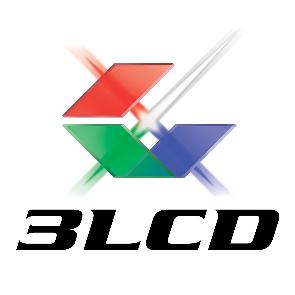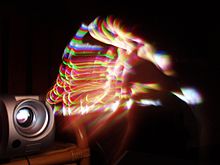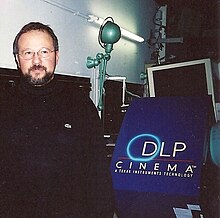
Digital cinema refers to the adoption of digital technology within the film industry to distribute or project motion pictures as opposed to the historical use of reels of motion picture film, such as 35 mm film. Whereas film reels have to be shipped to movie theaters, a digital movie can be distributed to cinemas in a number of ways: over the Internet or dedicated satellite links, or by sending hard drives or optical discs such as Blu-ray discs.

Home cinema, also called home theaters or theater rooms, are home entertainment audio-visual systems that seek to reproduce a movie theater experience and mood using consumer electronics-grade video and audio equipment that is set up in a room or backyard of a private home. Some studies show that films are rated better and generate more intense emotions when watched in a movie theater, but convenience is a major appeal for home cinemas. In the 1980s, home cinemas typically consisted of a movie pre-recorded on a LaserDisc or VHS tape; a LaserDisc Player or VCR; and a heavy, bulky large-screen cathode ray tube TV set, although sometimes CRT projectors were used instead. In the 2000s, technological innovations in sound systems, video player equipment and TV screens and video projectors have changed the equipment used in home cinema set-ups and enabled home users to experience a higher-resolution screen image, improved sound quality and components that offer users more options. The development of Internet-based subscription services means that 2020s-era home theatre users do not have to commute to a video rental store as was common in the 1980s and 1990s.

An overhead projector, like a film or slide projector, uses light to project an enlarged image on a screen, allowing the view of a small document or picture to be shared with a large audience.

An LCD projector is a type of video projector for displaying video, images or computer data on a screen or other flat surface. It is a modern equivalent of the slide projector or overhead projector. To display images, LCD projectors typically send light from a metal-halide lamp through a prism or series of dichroic filters that separates light to three polysilicon panels – one each for the red, green and blue components of the video signal. As polarized light passes through the panels, individual pixels can be opened to allow light to pass or closed to block the light. The combination of open and closed pixels can produce a wide range of colors and shades in the projected image.

In color reproduction and colorimetry, a gamut, or color gamut, is a convex set containing the colors that can be accurately represented, i.e. reproduced by an output device or measured by an input device. Devices with a larger gamut can represent more colors. Similarly, gamut may also refer to the colors within a defined color space, which is not linked to a specific device. A trichromatic gamut is often visualized as a color triangle. A less common usage defines gamut as the subset of colors contained within an image, scene or video.

A video projector is an image projector that receives a video signal and projects the corresponding image onto a projection screen using a lens system. Video projectors use a very bright ultra-high-performance lamp, Xenon arc lamp, metal halide lamp, LED or solid state blue, RB, RGB or remote fiber-optic RGB lasers to provide the illumination required to project the image. Most modern projectors can correct any curves, blurriness and other inconsistencies through manual settings.
Flicker is a visible change in brightness between cycles displayed on video displays. It applies to the refresh interval on cathode ray tube (CRT) televisions and computer monitors, as well as plasma computer displays and televisions.
A television set or television receiver is an electronic device for the purpose of viewing and hearing television broadcasts, or as a computer monitor. It combines a tuner, display, and loudspeakers. Introduced in the late 1920s in mechanical form, television sets became a popular consumer product after World War II in electronic form, using cathode ray tube (CRT) technology. The addition of color to broadcast television after 1953 further increased the popularity of television sets in the 1960s, and an outdoor antenna became a common feature of suburban homes. The ubiquitous television set became the display device for the first recorded media for consumer use in the 1970s, such as Betamax, VHS; these were later succeeded by DVD. It has been used as a display device since the first generation of home computers and dedicated video game consoles in the 1980s. By the early 2010s, flat-panel television incorporating liquid-crystal display (LCD) technology, especially LED-backlit LCD technology, largely replaced CRT and other display technologies. Modern flat panel TVs are typically capable of high-definition display and can also play content from a USB device. Starting in the late 2010s, most flat panel TVs began to offer 4K and 8K resolutions.
The contrast ratio (CR) is a property of a display system, defined as the ratio of the luminance of the brightest shade (white) to that of the darkest shade (black) that the system is capable of producing. A high contrast ratio is a desired aspect of any display. It has similarities with dynamic range.

A handheld projector is an image projector in a handheld device. It was developed as a computer display device for compact portable devices such as mobile phones, personal digital assistants, and digital cameras, which have sufficient storage capacity to handle presentation materials but are too small to accommodate a display screen that an audience can see easily. Handheld projectors involve miniaturized hardware, and software that can project digital images onto a nearby viewing surface.

An active shutter 3D system is a technique of displaying stereoscopic 3D images. It works by only presenting the image intended for the left eye while blocking the right eye's view, then presenting the right-eye image while blocking the left eye, and repeating this so rapidly that the interruptions do not interfere with the perceived fusion of the two images into a single 3D image.
The grating light valve (GLV) is a "micro projection" technology that operates using a dynamically adjustable diffraction grating. It competes with other light valve technologies such as Digital Light Processing (DLP) and liquid crystal on silicon (LCoS) for implementation in video projector devices such as rear-projection televisions. The use of microelectromechanical systems (MEMS) in optical applications, which is known as optical MEMS or micro-opto-electro-mechanical structures (MOEMS), has enabled the possibility to combine the mechanical, electrical, and optical components in tiny-scale.

A CRT projector is a video projector that uses a small, high-brightness cathode ray tube (CRT) as the image generating element. The image is then focused and enlarged onto a screen using a lens kept in front of the CRT face. The first color CRT projectors came out in the early 1950s. Most modern CRT projectors are color and have three separate CRTs, and their own lenses to achieve color images. The red, green and blue portions of the incoming video signal are processed and sent to the respective CRTs whose images are focused by their lenses to achieve the overall picture on the screen. Various designs have made it to production, including the "direct" CRT-lens design, and the Schmidt CRT, which employed a phosphor screen that illuminates a perforated spherical mirror, all within an evacuated cathode ray tube.

An ultra-high-performance lamp, often known by the Philips trademark UHP, is a high-pressure mercury arc lamp. These were originally known as ultra-high-pressure lamps, because the internal pressure can rise to as much as 200 atmospheres when the lamp reaches its operating temperature. It was developed by Philips in 1995 for use in commercial projection systems, home theatre projectors, MD-PTVs and video walls. Unlike other common mercury vapor lamps used in projection systems, it is not a metal halide lamp, as it uses only mercury. Philips claims a lifetime of over 10,000 hours for the lamps. These lamps are highly efficient compared to other projection lamps – a single 132 watt UHP lamp is used by DLP manufacturers such as Samsung and RCA to power their DLP rear-projection TV lines. It is used in many LCD and DLP video projectors.
Fulldome refers to immersive dome-based video display environments. The dome, horizontal or tilted, is filled with real-time (interactive) or pre-rendered (linear) computer animations, live capture images, or composited environments.
Laser color television, or laser color video display, is a type of television that utilizes two or more individually modulated optical (laser) rays of different colors to produce a combined spot that is scanned and projected across the image plane by a polygon-mirror system or less effectively by optoelectronic means to produce a color-television display. The systems work either by scanning the entire picture a dot at a time and modulating the laser directly at high frequency, much like the electron beams in a cathode ray tube, or by optically spreading and then modulating the laser and scanning a line at a time, the line itself being modulated in much the same way as with digital light processing (DLP).

Large-screen television technology developed rapidly in the late 1990s and 2000s. Prior to the development of thin-screen technologies, rear-projection television was standard for larger displays, and jumbotron, a non-projection video display technology, was used at stadiums and concerts. Various thin-screen technologies are being developed, but only liquid crystal display (LCD), plasma display (PDP) and Digital Light Processing (DLP) have been publicly released. Recent technologies like organic light-emitting diode (OLED) as well as not-yet-released technologies like surface-conduction electron-emitter display (SED) or field emission display (FED) are in development to supercede earlier flat-screen technologies in picture quality.

Rear-projection television (RPTV) is a type of large-screen television display technology. Until approximately 2006, most of the relatively affordable consumer large screen TVs up to 100 in (250 cm) used rear-projection technology. A variation is a video projector, using similar technology, which projects onto a screen.

The digital micromirror device, or DMD, is the microoptoelectromechanical system (MOEMS) that is the core of the trademarked Digital Light Processing (DLP) projection technology from Texas Instruments (TI). Texas Instrument's DMD was created by solid-state physicist and TI Fellow Emeritus Dr. Larry Hornbeck in 1987. However, the technology goes back to 1973 with Harvey C. Nathanson's use of millions of microscopically small moving mirrors to create a video display of the type now found in digital projectors.

3LCD is the name and brand of a major LCD projection color image generation technology used in modern digital projectors. 3LCD technology was developed and refined by Japanese imaging company Epson in the 1980s and was first licensed for use in projectors in 1988. In January 1989, Epson launched its first 3LCD projector, the VPJ-700.




























